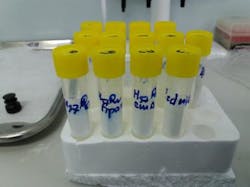Spectroscopy identifies antibiotic-resistant bacteria that causes tuberculosis
A team of physicists from Immanuel Kant Baltic State University (Kaliningrad, Russia) and colleagues used a spectroscopy method to quickly identify single antibiotic-resistant bacteria cells that are the agents of tuberculosis. The method helps find the bacteria and evaluate their resistance to antibiotics without damaging the biological material.
The disease caused by antibiotic-resistant strains of Mycobacterium tuberculosis is the most dangerous. The strains of the Beijing family (named after the city they were first observed in) have also become resistant to many medicinal drugs. Methods of quick identification of drug-resistant bacteria are required both for clinical practice and scientific research.
So the researchers, in collaboration with colleagues from the Saint-Petersburg State Research Institute of Phthisiopulmonology and Saint-Petersburg State University, suggested using Raman scattering spectrography to quickly analyze bacterial cells. This method helps identify the composition and structure of the studied material based on the scattering of laser radiation with certain wavelength by its sample. Spectroscopy is a noninvasive method—that is, the material under study is not subject to any mechanical impact or destruction.
The study materials were provided by Saint-Petersburg State Research Institute of Phthisiopulmonology. The authors used bacterial strains obtained from lung expectorations of tuberculosis patients, as well as from bone tissue samples taken during surgeries. Before the experiments with Raman scattering spectrography, the level of drug resistance of the bacteria was determined using standard biological and chemical methods.
Related: Fluorescence imaging method can detect tuberculosis infection in an hour
To obtain information about the structure of the cells belonging to different strains, the scientists pointed the laser beam at different bacteria during the spectroscopy procedure. The cells of different strains appeared to scatter the light differently because resistance to antibiotics occurs, among other things, due to changes in the composition of bacterial cell wall components. Spectroscopy helped identify differences in the cell walls of drug-resistant and drug-sensitive bacteria.
Full details of the work appear in the journal Data in Brief.
